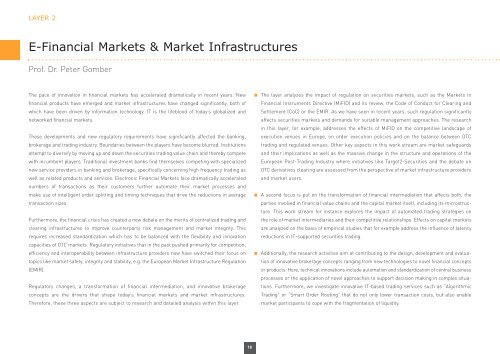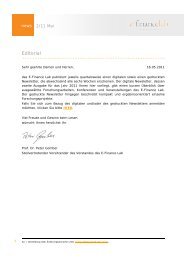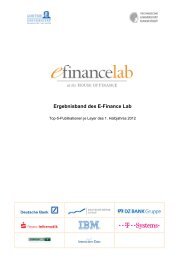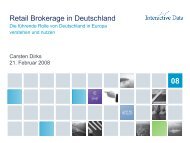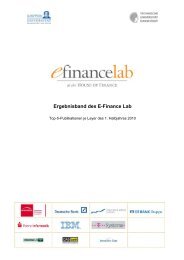The E-Finance Value Chain - E-Finance Lab Frankfurt am Main
The E-Finance Value Chain - E-Finance Lab Frankfurt am Main
The E-Finance Value Chain - E-Finance Lab Frankfurt am Main
Create successful ePaper yourself
Turn your PDF publications into a flip-book with our unique Google optimized e-Paper software.
LAYER 2<br />
E-Financial Markets & Market Infrastructures<br />
Prof. Dr. Peter Gomber<br />
<strong>The</strong> pace of innovation in financial markets has accelerated dr<strong>am</strong>atically in recent years: New<br />
financial products have emerged and market infrastructures have changed significantly, both of<br />
which have been driven by information technology. IT is the lifeblood of today’s globalized and<br />
networked financial markets.<br />
<strong>The</strong>se developments and new regulatory requirements have significantly affected the banking,<br />
brokerage and trading industry. Boundaries between the players have become blurred. Institutions<br />
attempt to diversify by moving up and down the securities trading value chain and thereby compete<br />
with incumbent players. Traditional investment banks find themselves competing with specialized<br />
new service providers in banking and brokerage, specifically concerning high frequency trading as<br />
well as related products and services. Electronic Financial Markets face dr<strong>am</strong>atically accelerated<br />
numbers of transactions as their customers further automate their market processes and<br />
make use of intelligent order splitting and timing techniques that drive the reductions in average<br />
transaction sizes.<br />
Furthermore, the financial crisis has created a new debate on the merits of centralized trading and<br />
clearing infrastructures to improve counterparty risk management and market integrity. This<br />
requires increased standardization which has to be balanced with the flexibility and innovation<br />
capacities of OTC markets. Regulatory initiatives that in the past pushed primarily for competition,<br />
efficiency and interoperability between infrastructure providers now have switched their focus on<br />
topics like market safety, integrity and stability, e.g. the European Market Infrastructure Regulation<br />
(EMIR).<br />
Regulatory changes, a transformation of financial intermediation, and innovative brokerage<br />
concepts are the drivers that shape today’s financial markets and market infrastructures.<br />
<strong>The</strong>refore, these three aspects are subject to research and detailed analysis within this layer.<br />
18<br />
n <strong>The</strong> layer analyzes the impact of regulation on securities markets, such as the Markets in<br />
Financial Instruments Directive (MiFID) and its review, the Code of Conduct for Clearing and<br />
Settlement (CoC) or the EMIR. As we have seen in recent years, such regulation significantly<br />
affects securities markets and demands for suitable management approaches. <strong>The</strong> research<br />
in this layer, for ex<strong>am</strong>ple, addresses the effects of MiFID on the competitive landscape of<br />
execution venues in Europe, on order execution policies and on the balance between OTC<br />
trading and regulated venues. Other key aspects in this work stre<strong>am</strong> are market safeguards<br />
and their implications as well as the massive change in the structure and operations of the<br />
European Post-Trading Industry where initiatives like Target2-Securities and the debate on<br />
OTC derivatives clearing are assessed from the perspective of market infrastructure providers<br />
and market users.<br />
n A second focus is put on the transformation of financial intermediation that affects both, the<br />
parties involved in financial value chains and the capital market itself, including its microstructure.<br />
This work stre<strong>am</strong> for instance explores the impact of automated trading strategies on<br />
the role of market intermediaries and their competitive relationships. Effects on capital markets<br />
are analyzed on the basis of empirical studies that for ex<strong>am</strong>ple address the influence of latency<br />
reductions in IT-supported securities trading.<br />
n Additionally, the research activities aim at contributing to the design, development and evaluation<br />
of innovative brokerage concepts ranging from new technologies to novel financial concepts<br />
or products. Here, technical innovations include automation and standardization of central business<br />
processes or the application of novel approaches to support decision making in complex situations.<br />
Furthermore, we investigate innovative IT-based trading services such as “Algorithmic<br />
Trading” or “Smart Order Routing” that do not only lower transaction costs, but also enable<br />
market participants to cope with the fragmentation of liquidity.


